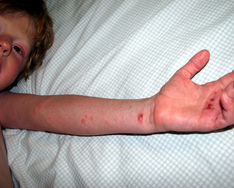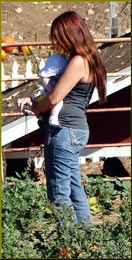 Cold and Flu season stats Over 200 different viruses cause influenza and influenza-like illness (fever, headaches, aches and pains, coughs, runny nose). Without doing lab testing, it is very difficult for doctors to determine the difference between the two. Both last for days and rarely lead to death or serious illness. According to a recent Cochrane review, the flu vaccine might only be effective against Influenza A and B, which represents about 10% of all circulating viruses (Jefferson et al, 2013). The authors’ conclusion from that review was, “Influenza vaccines have a modest effect in reducing influenza symptoms and working days lost. There is no evidence that they affect complications, such as pneumonia, or transmission.” (Jefferson et al., 2013). Period of contagiousness You may be able to pass on the flu to someone else before you know you are sick, as well as while you are sick. Most healthy adults may be able to infect others beginning 1 day before symptoms develop and up to 5 to 7 days after becoming sick. Some people, especially young children and people with weakened immune systems, might be able to infect others for an even longer time. How flu spreads Most experts believe that flu viruses spread mainly by droplets made when people with the flu cough, sneeze or talk. These droplets can land in the mouths or noses of people who are nearby. Less often, a person might also get flu by touching a surface or object that has flu virus on it and then touching their own mouth, eyes or possibly their nose. What Can We Do? There are many things we can do to help prevent illness throughout the winter season. Basic Strategies: 1)Eat fresh whole foods: Eating a variety of fresh whole foods including plenty of colourful fruits and vegetables is essential to proper immune function 2)Avoid refined sugars, trans fats and salt: These foods are known to weaken the immune system. 3)Increase your consumption of vitamin C containing foods: Vitamin C is known to boost immune function and help prevent cold and flus. Increase vitamin C containing foods such as: oranges, lemons, grapefruit, strawberries, raspberries, black currants, peppers, spring greens, brussel sprouts, broccoli, cauliflower, etc. 4)Eat more garlic and onions: Garlic and onions both have anti-viral and anti-bacterial properties, helping the body to fight off any germs it may come into contact with. (Raw consumption provides a greater benefit than cooked) 5)Drink up: Ensuring you are adequately hydrated will help enhance your immune system. Aim for half your weight in fluid ounces. (ex. If you weigh 150lbs, you should consume 75oz. of water a day) 6)Sleep, Sleep, Sleep: Ensure you are getting around 8 hrs of sleep per night and you are sleeping soundly. Too little non-restorative sleep is known to weaken the immune system. 7)Exercise: Engage in at least 20 minutes of physical activity per day. Exercise helps to increase circulation and lympathic flow, both of which help boost the immune system. 8)Breathe: Practice deep breathing exercises to help manage stress. High stress, fear, and worry can weaken the immune system, making you more susceptible to infections. 9)Wash hands: Wash your hands frequently using warm water and a natural anti-bacterial soap to prevent the spread of infection. 10)Cover your Cough: Cough or sneeze into your sleeve to prevent spreading infection and avoid touching your nose, mouth, eyes until hands are washed. Herbal Teas In a Harvard study, they found that people who drank 5 cups a day of black tea for 2 weeks had 10 times more virus-fighting interferon in their blood than others who drank a placebo hot drink. The amino acid responsible for this immune boost, L-theanine, is abundant in both black and green tea—decaf versions have it, too. Your optimal dose: Several cups daily. To get up to five times more antioxidants from your tea bags, bob them up and down while you brew.
Note: This information is not meant to replace the advice of a trained practitioner. In order to formulate a proper treatment plan, you should consult with your Naturopathic Doctor or other health care provider. Resources: Center for Disease Control and Prevention. (2013). Seasonal Influenza: Key Facts about Influenza (Flu) & Flu Vaccine. http://www.cdc.gov/flu/keyfacts.htm Hoffmann, D. (2003). Medical Herbalism: The Formulation and Preparation of Herbal Medicines. Healing Arts Press. Print. Jefferson et al. (2013). Vaccines to prevent influenza in health adults. http://summaries.cochrane.org/CD001269/vaccines-to-prevent-influenza-in-healthy-adults. Ontario Association of Naturopathic Doctors. (2013). Staying Healthy in Cold and Flu Season. http://www.oand.org/staying-healthy-in-cold-and-flu-season/ Public Health Agency of Canada. (Nov 2, 2013). Flu Watch: Influenza/ILI Activity (geographic spread). http://www.phac-aspc.gc.ca/fluwatch/13-14/w44_13/pdf/fw2013-44-eng.pdf
1 Comment
 I recently stumbled upon this great recipe posted by a future colleague of mine, Talia Marcheggiani. It works great for any meal or a healthy snack on the go. You get your protein and green leafy vegetable in a compact, easy to transport format. I haven’t tried freezing them yet (they’ve disappeared before I could even try), but I imagine a big batch would freeze well for leftovers. I've also tried experimenting with the spices, so if you're the more adventurous type, try throwing in some paprika or pepper and garlic powder to change up the taste a little. Ingredients: 6 eggs 1/2 roll goat cheese 1/2 bushel of kale 1/4 cup non-dairy milk of your choice (unflavoured and unsweetened) 3 tbs arrowroot powder or cornstarch 1 pinch baking soda 1 pinch nutmeg salt and pepper to taste Directions: Preheat oven to 375 degrees farenheit. In a pan, saute small pieces of kale with olive oil on low. In a large bowl, whisk eggs, cheese, arrowroot, milk and spices until smooth. Don’t worry about chunks of goat cheese. When kale is soft, spoon even amounts into a greased muffin tin. Spoon even amounts of egg mixture on top of kale. Season with salt and pepper. You may find you need muffin paper cups if your pans aren't as non-stick as they should be. Cook in the oven for 10 minutes. Check to make sure the egg has cooked all the way through by inserting a clean knife into the middle of one of the frittatas. Does it come out clean? Then these guys can be taken out of the oven to cool. When cool, use a spatula to remove mini frittatas from the muffin tin. Serve for breakfast or pack into glass portable containers to bring for lunch or a snack. Talia also maintains her own blog called Art & Practice: A naturopathic medical student's perspective. You can check out this and other recipes at: http://taliamarcheggiani.com/resources/.  What Is Eczema? The skin is an important organ of elimination, communication and protection. The body is trying to tell us that something is wrong when we see symptoms like eczema. Eczema and other skin issues have become a very common problem, usually affecting children and babies. The typical presentation of eczema is a scaly, red and itchy rash that appears on the creases of the elbows, back of the knees, behind the ears, on hands and on the face. This results from chronic inflammation that manifests in the skin, which is termed atopic dermatitis. Atopic conditions occur due to an imbalance in the immune system, which has caused it to become hypersensitive and thus prone to developing other hypersensitive reactions, such as asthma. What Causes Eczema? There are many contributing factors to the development of eczema. These include: - Environmental trigger(s): chemical irritants, soaps, lotions, and laundry detergent can all contribute to skin irritation - Food sensitivities: food allergens (eg. peanuts or diary), and chemicals, additives, or oils in processed foods can cause the rash to worsen - Stress: Stress can also undermine the whole system, and contribute to the development of skin issues. Keeping a stress free environment as much as possible, can be very helpful - Improper Elimination: when the organs of elimination (liver, skin, bowels, or urinary system) are overtaxed or underperforming toxins can remain in the body and contribute to skin problems. - Antibiotics: Overuse or improper use can severely disrupt the normal flora of the body. This is a risk factor for skin issues, especially in young children. How Is Eczema Treated? The conventional treatment for eczema is corticosteroid cream, combined with rounds of antibiotics if the skin is severely compromised and there is concern of infection. While this may be necessary in extreme cases, it also has side effects of thinning the skin and steroid resistance, among others. From a natural medicine perspective there are a number of things that can be done to help treat and prevent eczema. - Eliminate allergens from the diet. Some of the most common ones are wheat, dairy, soy, eggs and corn. - Decrease stress. Stress produces a hormone called cortisol, which can actually make skin conditions worse. Exercise, meditation and spending time doing things you enjoy can help decrease stress. - Minimize exposure to environmental triggers. Try using chemical free skin products and laundry detergent. Many products are labeled ‘for sensitive skin’. - Improve immune function. There are many things that can be done to help optimize the immune system. Eating a balanced diet of whole foods, including sources of omega 3s and fermented foods for probiotics, can minimize flare-ups. - Maximize routes of elimination. Ensuring that the liver, skin, bowels and urinary system are functioning optimally can keep toxin levels to a minimum and help keep the skin in better condition. Good detoxification foods include the dark leafy greens and spices like turmeric. Itch Relief The itch caused by eczema can be the worst part of eczema. Many children will itch their skin until it is raw, blistered and bleeding to get relief. Some helpful strategies for dealing with the itch include: - Homeopathic Remedies: Certain homeopathic remedies can be very helpful with minimizing the itch. Since each case is somewhat different, it is important to get a proper assessment from a trained practitioner. - Topical creams: natural topical creams that are free of chemicals can be helpful for minimizing itch. - Cool compress: placing a cold cloth over the affected skin can often provide temporary relief if an oatmeal bath cannot be taken at the time. Watching a child suffer from eczema can be a very stressful experience for a parent. If your child is suffering from eczema or you suspect they are, it is best to take them to a Naturopathic Doctor who can perform a proper assessment and form a treatment plan that will address your child’s needs. Always speak to your health care provider before beginning any new medications or supplements. References: 1. Stoppler, MC. (2012). Eczema. Reviewed by Schiel Jr., WC. MedicineNet. http://www.onhealth.com/eczema/article.htm. 2. Romm, A. 2003. Naturally Healthy Babies and Children: A Commonsense Guide to Herbal Remedies, Nutrition, and Health. Celestial Arts. 3. Skowron, JM. 2009. Fundamentals of Naturopathic Pediatrics. CCNM Press. Print.  Baby Blues and Postpartum Depression For a new Mother, emotional fluctuations, like going from joy to crying in a matter of a minute can be completely normal. Your body has just undergone a tremendous change, giving birth to the equivalent of a football or watermelon. Due to all the changes and adjustments still occurring, some emotional rollercoaster moments are to be expected. However, it’s also important to recognize when it might be something more, which you need some help to deal with. Baby Blues The ‘Baby Blues’ are usually defined as periods of weepiness, anxiety, and irritability that generally occur between 3 and 10 days after birth, and last several hours to several days. Studies indicate 30-80% of all women will experience baby blues. The best treatment is to express your feelings, ask for more support, get plenty of rest, especially when the baby rests, eat well, and drink plenty of fluids. Postpartum Depression Postpartum Depression (PPD) is thought to affect between 4 and 28 percent of all mothers. PPD can occur anytime in the first year postpartum, and sometimes extend beyond this time. Symptoms include: irritability, guilt, hopelessness, despair, insomnia, difficulty concentrating, confusion, inability to cope, thoughts of hurting oneself or baby, loss of normal interests, and a number of other symptoms. What distinguishes PPD from baby blues is the duration, severity, and complexity of symptoms. Feeling some of these feelings doesn’t mean you have PPD, but if the symptoms are severe, you have many, or they are persistent, then speak with your health care provider. Studies have shown even talking with a therapist can lead to significant improvement (O’Hara et al. 2000). Interestingly, breastfeeding may play a protective role as it’s been shown that mothers who breastfeed may be significantly less likely to develop PPD (Abou-Saleh et al. 1998). What you eat can also make a difference. The importance of proper nutrition cannot be underestimated, especially the need for essential fatty acids, protein, B vitamins, zinc, and iron. Significant blood loss during birth can also lead to anemia, which can predispose to depression. Low blood sugar and fatigue can also contribute, so ensuring enough caloric intake and enough rest can be helpful. If you think you or someone you know is suffering from PPD, talk to your health care provider. The sooner help is sought, the better the chances are for a positive outcome. References: 1. Abou-Saleh, MT et al. “Hormonal aspects of postpartum depression” Psychoneuroendocrinology. (1998 July); 23(5):465-75. 2. O’Hara, MW et al. “Effect of interpersonal psychotherapy for postpartum depression.” Arc Gen Psychiatry. (2000 November); 57(11):1039-45. 3. Romm, A. 2002. Natural Health after Birth: The Complete Guide to Postpartum Wellness. Healing Arts Press. |
Sarah Connors
I am a Naturopathic Doctor and Doula providing care in the Kitchener-Waterloo area. I have a passion for helping people with their health issues and improving the birth experience for Moms, and their babies. I also have a life long love affair with soccer, curling, and the alto saxophone. Archives
November 2020
Categories
All
|
Photos from Rural Royalty, manu flickr2010, Ryan Dickey, wocintechchat, huskyte77, paulswansen, Black Room Photography, harum.koh, Emery Co Photo, JeepersMedia, BrownGuacamole, wellnesswildflower, JeepersMedia, vastateparksstaff, colindunn, seelensturm, /\ \/\/ /\, 50mm.za, The Simpsons (Lee, Shirley, Luke and Rachel), AGRONAUTI, aivas14, Jonathan Rolande, winnifredxoxo, juhansonin, osseous, nan palmero, Theo Crazzolara, brianfagan, TP studio, wuestenigel, torbakhopper, anka.albrecht, Michael Stern, [-ChristiaN-], franchiseopportunitiesphotos, terren in Virginia, nateOne, barnimages.com, Dun.can, wuestenigel, @lattefarsan, amandabhslater, aphrodite-in-nyc, nutritionaldoublethink, Anne Worner, donnierayjones, mikecogh, angeloangelo, Rob.Bertholf, getaiwan, Lida Rose, matsuyuki, SurFeRGiRL30, marcoverch, amsfrank, mdaltry, nutrition education, Mike Prince, Edsel L, Neighborhood Nini, philipp.alexander.ernst, Mediocre2010, homethods, quinn.anya, Gamma Man, katerha, Eric Kilby, National Institutes of Health (NIH), rcmd_cfdfw_5_2, curtis palmer, Ray in Manila, frankieleon, Airsoftpal.com, byzantiumbooks, cchana, Brian Legate, Matt Lavin, BradHinton, monpetitchouphotography, wuestenigel, alexisjordanlewis, ByEPhotos, erix!, RLHyde, return the sun, quinn.anya, mliu92, frankieleon, loudista, Lyn Lomasi, upslon, derrickbrutel, cchana, National Institutes of Health (NIH), watts_photos, marcoverch, derrickbrutel, francesbean, weegeebored, Airsoftpal.com, Etwood, wu_135, shixart1985, Ingrid Taylar, VeritasFotografie, BioDivLibrary, emmanuelmorales1, Thanks for 1.5 Million Views!!, Will Merydith, reader of the pack, RoxyHobbs, Khanelle Prod' Medias, storyvillegirl, agromonitor, Arenamontanus, six:eleven, cote, SweetOnVeg, nenoirenediaz, lucianvenutian, markhillary, anotherlunch.com, inkknife_2000, archibald jude, rawtrigger, Imaginary Museum Projects: News Tableaus, Pavel P., Courtney Emery, Thien Gretchen, physiognomist, bark, Michigan Municipal League (MML), alberth2, Merelymel13, neofob, Care_SMC, Parker Knight, B*2

 RSS Feed
RSS Feed
